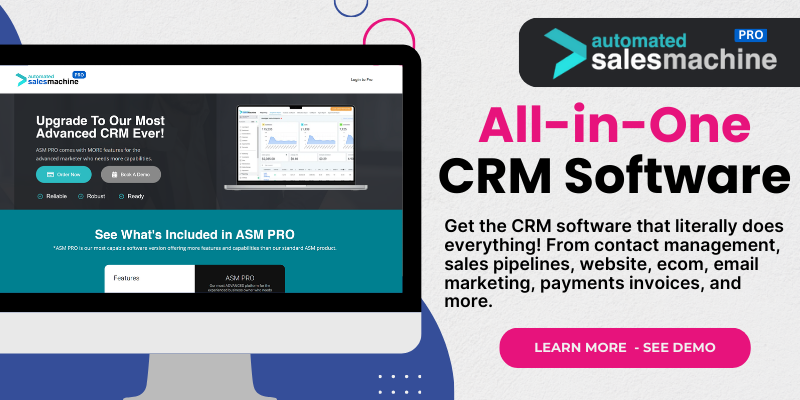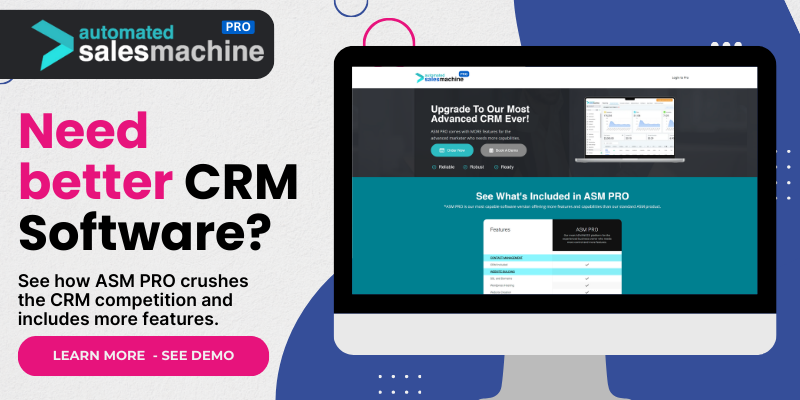Increased Efficiency and Productivity
Streamlining Processes
One of the first things I noticed when implementing sales force automation within my CRM was how it drastically streamlined my daily processes. Tasks that used to take me hours could now be completed in record time. For instance, automating repetitive tasks like data entry freed up my time, allowing me to focus on what truly matters—building relationships and closing deals.
The beauty of automation lies in its ability to eliminate the mundane. Think about it—how much time do you spend manually entering data or sending follow-up emails? With the right CRM in place, these tasks can be automated, reducing the risk of human error and increasing overall accuracy.
So, if you’re looking to boost your productivity, investing in a solid sales force automation tool within your CRM is one of the best moves you can make!
Real-Time Data Access
Real-time data access is another major perk. When I can see live updates about my sales pipeline, customer interactions, and team performance, I feel empowered to make decisions on the fly. No more waiting for reports to come out at the end of the week—everything I need is at my fingertips.
This ability to access real-time analytics helps me identify trends and make strategic decisions faster than ever. If I notice a dip in sales in a particular area, I can respond immediately rather than waiting until it becomes a larger issue.
Plus, real-time data fosters transparency within the team, allowing everyone to stay on the same page. It creates a more collaborative and communicative environment, which I always appreciate.
Enhanced Customer Relationship Management
Cultivating strong relationships with customers is essential for long-term success. With sales force automation, I’ve found that I’m better equipped to manage these relationships effectively. Automated reminders and follow-ups mean that no customer feels neglected.
This personalized touch makes a world of difference. When I reach out to clients on their birthdays or follow up on past conversations, they feel valued. It’s those little gestures that lead to higher satisfaction and loyalty.
Moreover, I can easily track interactions and preferences, which further personalizes the experience. Having that data organized in a user-friendly manner is a game-changer.
Improved Sales Forecasting
Using Historical Data
One of the key benefits I’ve experienced is improved sales forecasting. By utilizing historical data and sales trends from my CRM, I can develop more accurate predictions about future sales. It’s fascinating to analyze the patterns over time and use them to guide my team’s strategies.
With this historical insight, I can identify factors that contributed to past successes—and, conversely, areas that could use a bit of tweaking. It’s like having a crystal ball that allows me to plan ahead effectively.
And the bottom line? Better forecasting leads to enhanced resource allocation, which is critical for any growing business. I can confidently allocate budget and human resources where they’re needed most, based on accurate predictions.
Recognizing High-Value Opportunities
Sales force automation also helps in identifying high-value sales opportunities. I’m usually juggling various leads, but automation sifts through them, highlighting where my time and efforts are best spent.
By monitoring lead scores and behavior through the CRM, I can prioritize my follow-ups with those who are more likely to convert. Instead of wasting hours on low-potential leads, I focus on nurturing relationships with high-value clients.
This targeted approach not only increases my chances of closing sales but also enhances my overall efficiency. Focusing on the right opportunities feels incredibly rewarding!
Boosting Team Collaboration
Collaboration within the sales team can sometimes feel like herding cats, but sales force automation greatly simplifies that. With a centralized CRM, everyone can access the same information without stepping on each other’s toes.
It’s super helpful for maintaining clarity about who is working on what, which means that we’re less likely to duplicate efforts or miss important updates. This seamless communication translates to a more cohesive team that works smarter, not harder.
Additionally, I find that people are more engaged when they know what the rest of the team is doing. It fosters a culture of accountability and encourages everyone to contribute, making our overall teamwork much more productive!
Enhanced Reporting and Analytics
Visualizing Performance Metrics
I’m a huge fan of data visualization, and the sales force automation tools in my CRM take reporting to the next level. With dynamic dashboards, I can easily visualize how my team is performing across different metrics—all at a glance.
This allows me to monitor KPIs and other vital statistics in real time. Understanding this data not only helps me adjust strategies on the fly but also enables me to prepare comprehensive reports for higher management without breaking a sweat.
Having this information presented neatly helps me communicate insights clearly with my team and stakeholders. It makes the data more digestible and actionable, which is what we all aim for, right?
Customizable Reporting Features
Customization is king when it comes to reporting. What I appreciate about my CRM is that I can tailor reports to focus on specific metrics that matter most to my team or project goals. This means no more one-size-fits-all approaches!
By being able to customize my reports, I can emphasize the areas where I want to see growth, fostering a targeted approach to improving those metrics. This level of flexibility drastically enhances our reporting process.
Ultimately, it means I spend less time crunching numbers and more time implementing effective strategies.
Regular Performance Assessment
Another critical aspect of enhanced reporting is the ability to conduct regular performance assessments. By regularly reviewing where my team stands, I can identify areas of strength and opportunities for improvement.
This cyclical approach helps keep our goals aligned and gives us a steady course direction rather than just flying by the seat of our pants. Regular assessments help foster accountability and drive us towards our targets.
I truly believe that consistent performance evaluations are key to sustaining growth and success. They help us celebrate our wins while also addressing any shortcomings without playing the blame game.
Increased Revenue Generation
Reducing Sales Cycle Time
Once I started utilizing sales force automation, one of the most immediate benefits I noticed was a significant reduction in our sales cycle time. The efficiency brought by automating various steps means we can connect with prospects and close deals faster than ever.
Shortening the sales cycle is a game-changer not just for internal metrics but for hitting revenue goals too. It means more deals in the pipeline and quicker revenue realization. Who doesn’t want that?
Ultimately, the faster I can turn leads into loyal customers, the better our bottom line looks.
Identifying Upsell and Cross-Sell Opportunities
Another fantastic advantage of automation is the ability to identify upsell and cross-sell opportunities within my existing customer base. My CRM’s analytics tools dig into sales data and highlight products that customers are most likely to buy together.
This means I can tailor my approach to suggest additional products during a sale, enhancing the customer experience and increasing average order value. It’s not just about making a sale; it’s about delivering more value to the customer.
I’ve found that many customers appreciate the personalized recommendations and often feel that I’m providing them with valuable insights rather than just trying to upcharge them. Trust me; there’s a sweet spot to be found there.
Tracking Customer Lifetime Value
Understanding customer lifetime value (CLV) has become much easier with automated tools. I love that my CRM can help calculate the potential revenue I can expect from a customer over time. This insight is invaluable for making informed business decisions.
Knowing the CLV helps in determining how much I can afford to spend on acquiring new customers while still hitting profit targets. Additionally, I can focus my retention efforts on high-CLV customers, ensuring my investment yields high returns.
In the business world, we all know that retaining an existing customer is often cheaper than acquiring a new one. So, leveraging sales force automation to track and improve CLV is a no-brainer.
Strengthened Lead Management
Centralized Lead Database
With sales force automation, I’ve seen a marked improvement in how my team manages leads. The centralization of lead data within the CRM means that everyone has access to the same information, and we can track the status of each lead in real time.
This saves time when it comes to assigning leads and ensures that we don’t accidentally reach out to the same person multiple times. Clear, centralized lead management means we have a much more organized system that aids in improving overall efficiency.
The clarity this brings to our lead management process is something I truly value. It helps us make strategic decisions quickly and effortlessly.
Lead Scoring and Qualification
Lead scoring is another fantastic feature I’ve found useful. The CRM allows us to qualify leads based on pre-defined criteria, such as their level of engagement or demographic information. This means I can prioritize high-quality leads and focus my efforts where they’re most likely to pay off.
Utilizing lead scoring helps maintain my team’s motivation, too! When we can see which leads are heating up, it encourages my colleagues to pivot their efforts in the right direction rather than spreading themselves too thin.
Ultimately, qualifying leads through scoring leads to higher conversion rates and reduces the time spent on prospects that may not convert.
Automated Follow-Ups
Last but not least, automated follow-ups are a lifesaver. These reminders ensure that every lead receives timely follow-ups without relying on memory alone. I can set up sequences to send emails or notifications at strategic intervals.
This automation makes it possible to maintain a consistent communication rate with prospects, which ultimately keeps me on their radar. Missing follow-ups can mean missed opportunities, but automation keeps the process on track.
Being able to customize these follow-up actions ensures they feel personal rather than robotic, ultimately fostering better relationships with potential customers.
FAQ
What is sales force automation in CRM?
Sales force automation in CRM refers to using technology to streamline and automate various sales processes, which includes features like lead management, customer interactions, task reminders, and performance analytics—all aimed at increasing efficiency and revenue generation.
How does sales force automation improve productivity?
By automating repetitive and mundane tasks, sales force automation frees up time for sales teams to focus more on building relationships and closing deals, ultimately enhancing overall productivity.
What role does data analysis play in sales force automation?
Data analysis is crucial in sales force automation as it helps teams utilize historical data to predict future sales, identify potential upselling opportunities, and assess overall team performance effectively.
Can sales force automation help improve customer relationships?
Absolutely! Automated follow-ups and personalized communication foster stronger customer relationships by ensuring that clients feel valued and attended to without overwhelming the sales team.
Is implementing sales force automation difficult?
The implementation process can vary based on the CRM system chosen, but many modern solutions are designed to be user-friendly. With a bit of time for training, your team can effectively leverage sales force automation for better results.

